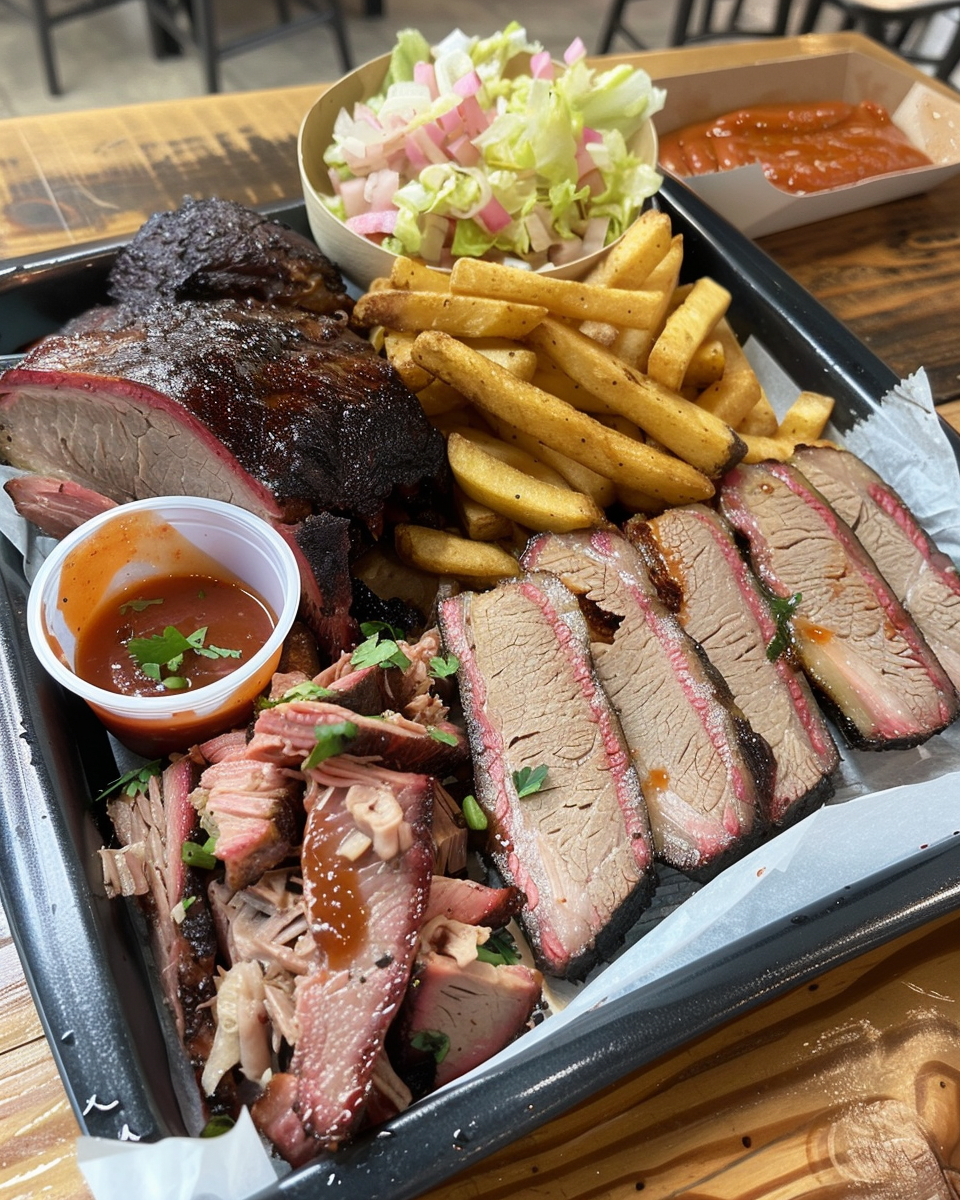Introduction
Hook:
Imagine the irresistible smell of smoky, slow-cooked meats wafting through the air—a blend of rich, charred beef and subtle hints of pepper, garlic, and oak smoke. This is the unmistakable aroma of Texas BBQ, a tradition so deeply rooted in the state’s culture that it’s more than just food; it’s an experience.
What is Texas BBQ?
Texas BBQ is a unique style of cooking that centers around slow-cooked, smoked meats, with a strong preference for beef, especially brisket. While many other BBQ styles lean heavily on sauces and marinades, Texas BBQ allows the natural flavors of the meat to shine through, often with a simple salt-and-pepper rub. The meat is smoked for hours—sometimes more than half a day—over low heat, absorbing the flavors of wood such as oak or mesquite, resulting in a rich, tender, and smoky delicacy.
Regional Styles of Texas BBQ:
Texas BBQ isn’t a monolith. The state’s vastness has given rise to distinct regional BBQ styles, each with its own unique flavors and techniques:
- Central Texas BBQ: The “meat market” style of BBQ hails from German and Czech immigrants. The meats are seasoned simply with salt and pepper and smoked over oak or hickory wood. It’s all about letting the meat speak for itself, with brisket being the main star.
- East Texas BBQ: Known for its heavily smoked meats, East Texas BBQ focuses on pork. The meat is cooked until fall-off-the-bone tender and often accompanied by sweet, tomato-based sauces that complement the smoky flavor.
- West Texas BBQ: This “cowboy style” BBQ employs direct heat grilling over mesquite wood. This method infuses the meat with a robust, earthy flavor. It’s quicker than the slow-smoking methods of other regions but no less flavorful.
- South Texas BBQ: With its roots in Mexican culture, South Texas BBQ often features barbacoa—traditionally whole cow heads slow-cooked in underground pits. The meat is tender and rich, often served with spicy, tangy sauces.
Popularity and Cultural Significance:
BBQ in Texas isn’t just a meal; it’s a cultural institution. Whether it’s a family gathering, a festival, or just a Saturday afternoon, BBQ brings people together. Texas BBQ joints like Franklin Barbecue in Austin or Snow’s BBQ in Lexington are famous nationwide, with lines that can last hours. The Houston BBQ Festival and similar events celebrate the diversity of the BBQ styles throughout the state, making BBQ more than just food—it’s a way of life.
Ingredients
For the Meats (Brisket, Ribs, and Sausages):
- Beef Brisket: The undisputed king of Texas BBQ. This cut comes from the lower chest of the cow, known for its toughness. When slow-cooked and smoked, the fat renders down, and the connective tissues break apart, resulting in a tender, flavorful piece of meat.
- Pork Spare Ribs: These ribs are another Texas BBQ staple, offering a slightly sweeter flavor. The ribs are smoked until the meat pulls easily from the bone, with just the right balance of fat and lean meat.
- Sausages: In Central Texas, sausages play a prominent role. These are typically made from a mix of beef and pork, seasoned with garlic, black pepper, and other spices, then smoked to develop a deep, flavorful snap when bitten into.
- Other Meats (Optional): Though brisket, ribs, and sausage are the stars, some Texas BBQ joints offer turkey, chicken, or lamb as alternatives, offering lighter options while maintaining the distinct smoky flavors.
For the Rubs and Marinades:
- Texas-Style Dry Rub for Brisket: A simple mix of coarse salt and black pepper, designed to enhance the meat’s natural flavors without overpowering it.
- Spice Rub for Pork Ribs: A balanced blend of brown sugar, paprika, garlic powder, onion powder, cayenne, and chili powder. This combination provides a sweet and spicy kick that pairs beautifully with pork.
- Marinades for South Texas BBQ: Often incorporating ingredients like lime juice, garlic, and chilies, these marinades add a bold, tangy flavor to meats like barbacoa.
Wood Choices:
Texas BBQ is all about wood-smoked flavor. Oak, hickory, and mesquite are the most popular woods, each imparting its own distinct taste. Oak provides a mild, smoky flavor, hickory adds a stronger, bacon-like flavor, and mesquite gives an earthy, slightly bitter taste.
For the Sides (Essential Accompaniments):
- Coleslaw: A creamy, tangy side that cuts through the richness of the smoked meats.
- Potato Salad: A classic BBQ side dish, often mustard-based with hard-boiled eggs for extra texture.
- Baked Beans: Slow-cooked with bacon and a hint of BBQ sauce, these beans are smoky, sweet, and savory.
- Pickles and Onions: Traditional accompaniments that provide a tangy contrast to the smoky meats.
- Cornbread or Texas Toast: Adds a soft, slightly sweet element to round out the meal.
For the Sauces:
Although Texas BBQ is typically more focused on the meat than the sauce, certain regions offer distinctive sauces:
- East Texas-Style Sweet BBQ Sauce: A ketchup-based sauce with a touch of molasses, ideal for pork ribs.
- Central Texas Minimalist Approach: Simple vinegar-based sauces that enhance the meat without overshadowing it.
- Spicy Mustard Sauce: Popular with sausages, this sauce provides a zesty, spicy contrast.
- South Texas Barbacoa Sauce: Often made with cilantro, lime, and chilies, this sauce has a Mexican influence, offering bold, bright flavors.
Instructions (Step-by-Step)
Step 1: Preparing the Meat
- Selecting the Brisket: Choose a brisket with good marbling (fat within the meat), as this fat renders down during the cooking process, keeping the brisket moist.
- Trimming the Brisket: Trim excess fat, but leave a layer to keep the meat juicy during the long cooking time.
- Prepping Ribs: Remove the tough membrane from the underside of the ribs for better rub absorption and a more tender texture.
Step 2: Applying the Rub
- Brisket Rub: Liberally apply the simple salt-and-pepper rub, ensuring even coverage.
- Ribs Rub: Massage the spice rub into the ribs, coating all sides evenly. For best results, let the meat sit with the rub overnight.
Step 3: Setting Up the Smoker
- Wood Choice and Preparation: Soak wood chips (oak, hickory, or mesquite) in water for at least 30 minutes. This ensures they smolder rather than burn.
- Temperature Control: Preheat the smoker to 225-250°F. This low-and-slow temperature is crucial for breaking down the meat’s collagen, resulting in tender, juicy BBQ.
Step 4: Smoking the Meat
- Smoking Brisket: Place the brisket in the smoker fat-side up. Smoke until the internal temperature reaches 203°F, which can take 10-14 hours. Wrap the brisket in butcher paper or foil midway through cooking to retain moisture (this is called the “Texas crutch”).
- Smoking Ribs: Use the 3-2-1 method: 3 hours of smoking, 2 hours wrapped in foil, and 1 hour unwrapped to firm up the bark.
- Smoking Sausages: Smoke the sausages until they reach an internal temperature of 160°F, ensuring they remain juicy inside with a nice snap on the casing.
Step 5: Resting the Meat
- Resting Brisket: Let the brisket rest for at least 30-60 minutes before slicing to allow the juices to redistribute.
- Resting Ribs: Let the ribs rest for 10-15 minutes before cutting them into portions.
Step 6: Serving the Sides
- Coleslaw: Whisk together mayonnaise, vinegar, sugar, and mustard to create the dressing. Toss with shredded cabbage and carrots.
- Potato Salad: Boil potatoes until tender, then mix with mustard, mayonnaise, chopped onions, and boiled eggs for a classic BBQ side.
- Baked Beans: Slow-cook beans with bacon and BBQ sauce until thick and smoky.
Serving Suggestions
Portion Sizes:
Plan for half a pound of brisket per person, along with a few ribs and one sausage link per serving.
How to Serve Texas BBQ:
Serve Texas BBQ traditionally on butcher paper or a metal tray with pickles, onions, and a slice of white bread or Texas toast.
Pairings:
- Beer Pairings: Local Texas beers like Shiner Bock or Lone Star are perfect for washing down smoky meats.
- Whiskey and Bourbon: Suggest pairing with a Texas-made whiskey for those who prefer something stronger.
- Non-alcoholic Options: Iced tea and lemonade are refreshing choices to balance the richness of BBQ.
Vegetable Sides:
Roasted corn, grilled vegetables, or a fresh garden salad offer light, healthy contrasts to the heavy meats.
Meal Customizations:
- Gluten-Free Options: Suggest serving the meats without bread or offer gluten-free sides.
- Vegetarian BBQ Options: Smoky portobello mushrooms or grilled vegetables can be great BBQ alternatives for vegetarians.
Conclusion
Recap the Flavors and Techniques:
Mastering Texas BBQ requires a balance of patience and technique. By selecting quality meats, applying simple but flavorful rubs, and maintaining the perfect smoking temperature, anyone can recreate the magic of Texas BBQ at home.
Highlight the Versatility of Texas BBQ:
The methods used in Texas BBQ can be adapted to a variety of meats and even different cooking methods like grilling or oven roasting.
Encourage Experimentation:
Texas BBQ is both a tradition and a personal expression. Try experimenting with different wood types, rubs, and sides to find your unique take on this culinary classic.
Call to Action:
Fire up your smoker, gather your ingredients, and get ready to immerse yourself in the world of Texas BBQ. Share your results, try out variations, and bring the flavors of the Lone Star State to your own backyard.
FAQs
What makes Texas BBQ different from other BBQ styles?
Texas BBQ emphasizes beef, especially brisket, and focuses on simple dry rubs, slow smoking, and allowing the meat’s natural flavors to shine, unlike Kansas City or Memphis BBQ, which often feature sweet or tangy sauces.
What’s the best meat for Texas BBQ?
Brisket is the most iconic, but ribs and sausages also play key roles. Each meat is smoked to perfection and seasoned in a way that complements its natural flavor.
What type of wood is used in Texas BBQ?
Oak, hickory, and mesquite are the most common woods. Oak provides a mild, smoky flavor, while mesquite offers a more intense, earthy taste.
How long does it take to smoke a brisket?
Smoking a brisket can take 10-14 hours at a low temperature of 225°F. The internal temperature should reach 203°F for the perfect texture.
Can I make Texas BBQ at home without a smoker?
Yes, you can use a charcoal grill with wood chips, an oven, or an electric smoker to recreate the flavors of Texas BBQ.
Do you need sauce for Texas BBQ?
Traditionally, Texas BBQ, particularly in Central Texas, is served without sauce. The focus is on the meat, but sauces can be offered on the side.

